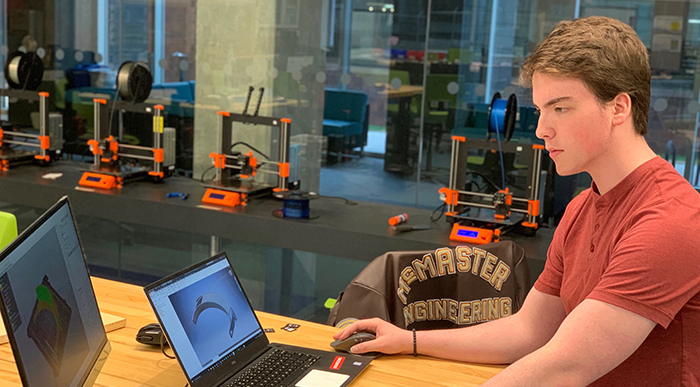Collaboration creates face shields for health-care workers

A collaboration between McMaster’s Faculties of Engineering and Faculty of Health Sciences, with the guidance of local physicians, is allowing for the design and production of much-needed face shields for Hamilton health-care workers.
The duo behind the initiative is Alec Fernback, an Engineering 1 student, and his dad, Mike Noseworthy, a professor in electrical and computer engineering and co-director of the McMaster School of Biomedical Engineering.
When in-person classes were cancelled and social distancing began about a month ago, it was natural for Fernback and Noseworthy to team up on a new project to help provide much-needed personal protective equipment for those battling COVID-19 on the front lines.
“This whole project has been a very exciting opportunity for me because I’ve been able to apply directly what I’ve learned in the classroom for real-world applications,” Fernback says from the iBioMed Design Studio where he and Noseworthy have carefully been working on face shield designs to 3D print.
Noseworthy says: “I’m glad Alec is here because he’s taught me how to use 3D printers, which I’m really happy about. We’re teaching each other here and taking advantage of this opportunity to learn more.”
The idea to repurpose the iBioMed Design Studio into a space to 3D print face shields was initiated by Tim Hillson, an assistant clinical professor of surgery in the Faculty of Health Sciences.
Hillson reached out to Noseworthy and Colin McDonald, director of Engineering 1, and within days, they were refining their initial prototypes with physicians at Hamilton Health Sciences and St. Joseph’s Healthcare Hamilton.
“The physicians have been really amazing with the feedback to engineering in general,” says Noseworthy, noting the challenges they were faced with from the start. “There’s lots of little things that need to be considered if the face shields are actually going to be used in a hospital – and assembly of the shields will require cleanliness and the right protocols.”
The face shields are being made in the first-year Engineering EPIC Lab and the iBioMed Design Studio, where there are 25 printers in total. So far, they have printed about 300 shields to which an assembly team will later attach clear plastic and latex-free straps.
Discussions with local manufacturers on 3D printing are ongoing, with the goal to increase production capacity.
This effort is largely supported by the Integrated Biomedical Engineering & Health Sciences program, also known as iBioMed program, which is the first Canadian health sciences program to bridge together health, engineering science and entrepreneurship. The program is a collaboration between the faculties of Health Sciences and Engineering.
“There’s so many people that have stepped up in engineering, science, health sciences – everybody,” says Noseworthy.
“The outpouring of wanting to help has been absolutely incredible, and the hardest part about it is trying to juggle using people’s offers of help, but we also have to maintain physical distancing.”
Fernback says he encourages other students to continue getting involved.
“Even just donating, volunteering or anything to help goes a long way – they don’t necessarily have to do what we’re doing,” he says.
2020, Research Project
